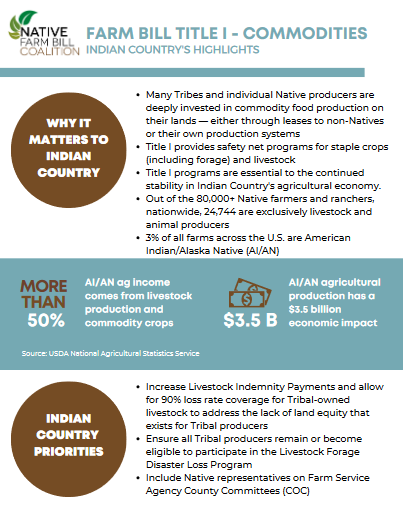FARM BILL TITLE I – COMMODITIES
INDIAN COUNTRY’S HIGHLIGHTS
WHY IT MATTERS TO INDIAN COUNTRY
- Many Tribes and individual Native producers are deeply invested in commodity food production on their lands — either through leases to non-Natives or their own production systems
- Title I provides safety net programs for staple crops (including forage) and livestock
- Title I programs are essential to the continued stability in Indian Country’s agricultural economy.
- Out of the 80,000+ Native farmers and ranchers, nationwide, 24,744 are exclusively livestock and animal producers
- 3% of all farms across the U.S. are American Indian/Alaska Native (AI/AN)
More than 50% of AI/AN ag income comes from livestock production and 50% commodity crops
AI/AN agricultural production has a $3.5 billion economic impact
INDIAN COUNTRY PRIORITIES
- Increase Livestock Indemnity Payments and allow for 90% loss rate coverage for Tribal-owned livestock to address the lack of land equity that exists for Tribal producers
- Ensure all Tribal producers remain or become eligible to participate in the Livestock Forage Disaster Loss Program
- Include Native representatives on Farm Service Agency County Committees (COC)
Livestock and commodity crop production account for more than 50% of all Indian Country agriculture income. This makes the Commodity Title’s Livestock Indemnity and other disaster programs very important to Indian Country. In addition to Indian Country’s own commodity production, non-Native farmers and ranchers frequently lease Tribal land to grow or raise agricultural products that fall under Commodity Title programs.
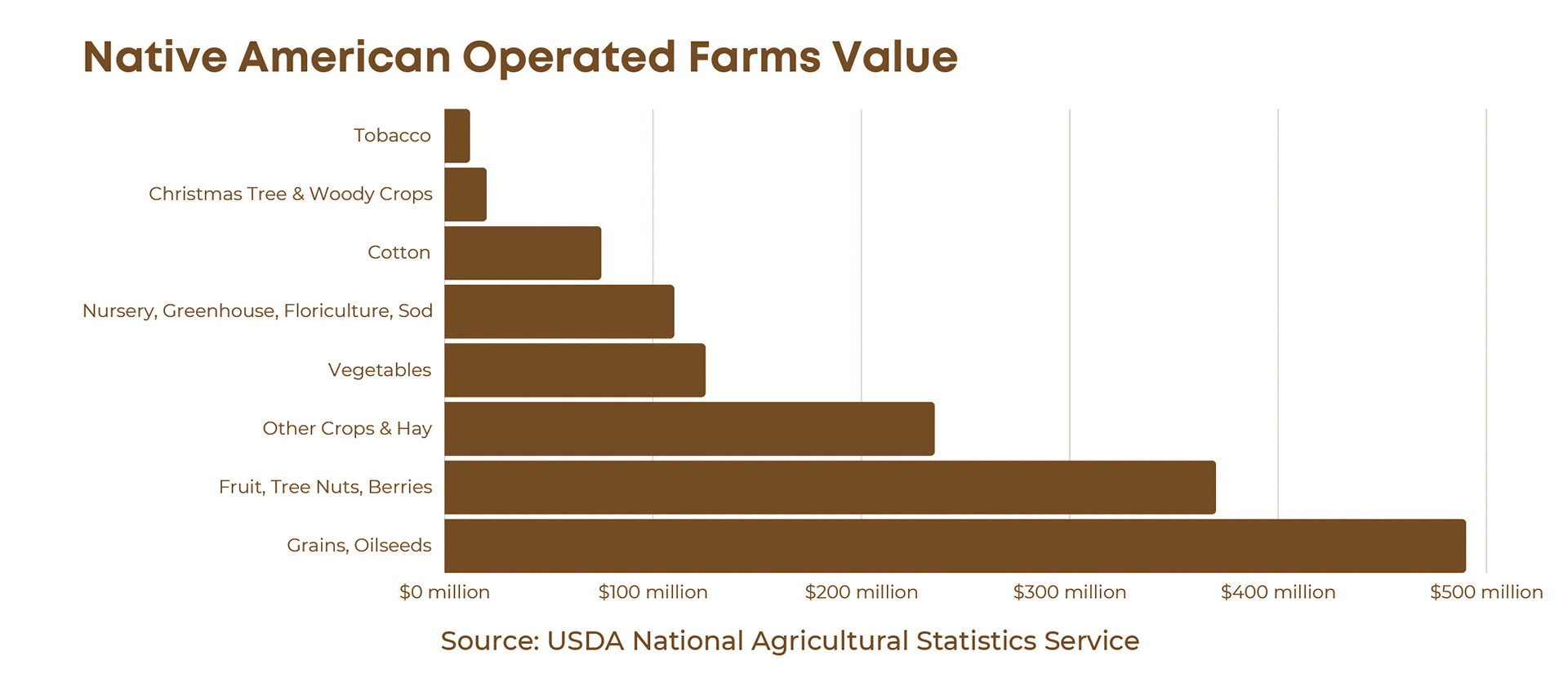
Ongoing droughts, flooding, and supply chain issues brought on by the pandemic and related issues have deeply and negatively impacted Native producers in recent years. Full access to all Commodity Title programs — particularly disaster assistance programs that help producers weather storms, both literal and figurative — is essential to continued stability in Indian Country’s agricultural economy.
FARM BILL TITLE II – CONSERVATION
INDIAN COUNTRY’S HIGHLIGHTS
WHY IT MATTERS TO INDIAN COUNTRY
- Title II helps producers and landowners implement proven conservation practices based on technical standards on agricultural and forest lands
- Conservation programs provide financial support for producers who want to implement land stewardship activities on their lands.
- For decades, Indian Country has expressed needs for improved conservation and land stewardship support from the USDA
When federal policy continues to apply state and local standards to Indian Country lands where the same circumstances, markets, governance structures, and land holdings simply do not exist, Indian Country will continue to struggle with accessing critical conservation programs contained in this title.
INDIAN COUNTRY PRIORITIES
- Enhance Natural Resources Conservation Service (NRCS) programming for Tribal producers
- Provide more support for Alternative Funding Arrangements (AFAs)
- Increase alternative models of program delivery — 638 self-determination and self-governance, and other flexibilities for Tribes
- Allow funding flexibility and the use of other federal funds to make match requirements
- Recognize traditional, ecological, and knowledge-based conservation
- Include Tribal priorities in definition of priority resource concerns
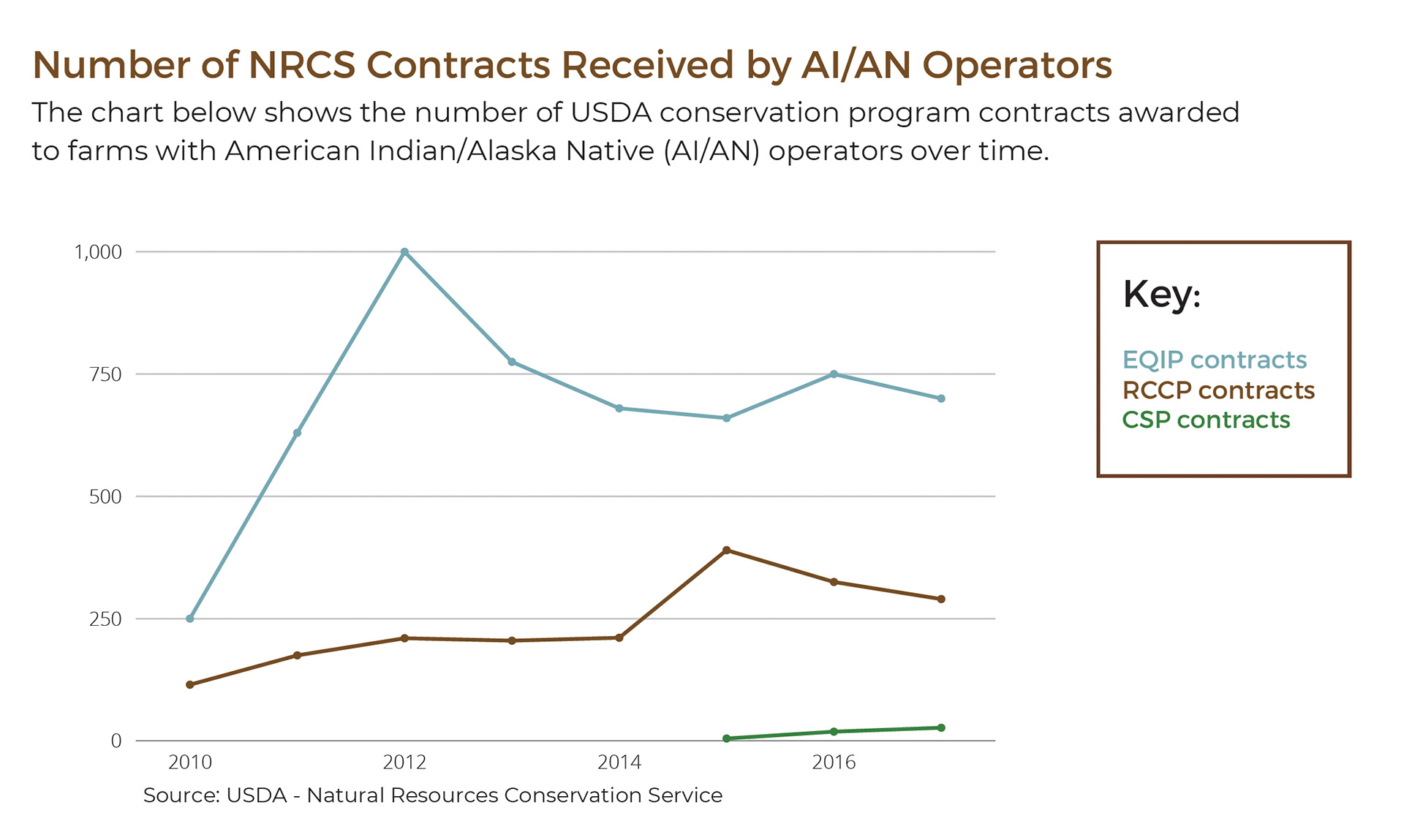
Historically, Tribal lands have suffered from a lack of conservation practices due to lack of tailored federal legislation that incorporates the challenges and unique nature of Tribal agricultural lands.
FARM BILL TITLE III – TRADE
INDIAN COUNTRY’S HIGHLIGHTS
WHY IT MATTERS TO INDIAN COUNTRY
- A growing number of Tribes are engaged in trade of food and agriculture products.
- There is increased global interest in American Indian trademarked products
- Title III illustrates how Tribal producers can access significant trade opportunities in international markets through USDA programs like the Market Access Program (MAP)
Despite the potential economic benefits of engaging in international trade, accessing international markets for any product is a challenging and complex process. This is especially true for food products. With resources and technical assistance that USDA programming can provide through Trade Title programs, the number of Tribal nations and Tribal producers accessing these profitable international markets can increase, improving economic realities across Indian Country.
Current MAP funding still reflects 2014 Farm Bill levels; MAP funding needs to be increased to support the expansion of Tribal products in oversees markets.
INDIAN COUNTRY PRIORITIES
- Expand the MAP to increase opportunities and access to overseas markets
- Promote Tribal parity in the MAP
- Include more Tribal producers in trade missions
- Support unique Tribal foods and fighting Native food fraud
- Increase interdepartmental coordination to support Tribal trade
INDIAN COUNTRY SUCCESS STORIES
- Red Lake Nation Foods recorded $88,000 of first-time export sales by using the MAP to market overseas.
- When Séka Hills of the Yocha Dehe Wintun Nation received the MAP funding, they reported immediate sales of $5,000 while also projecting $30,000 for the next 12 months.
ONLY 0.2% OF ALL MAP FUNDING GOES TO INDIAN COUNTRY
The Intertribal Agriculture Council is the leader in supporting Tribal producers in their export endeavors, yet they only receive 0.2% of all MAP funding.
Trade Title programs represent a significant opportunity for Indian Country producers and Tribally owned food businesses. Nativeproduced foods are often seen as highly desirable and financially lucrative niche products.
FARM BILL TITLE IV – NUTRITION
INDIAN COUNTRY’S HIGHLIGHTS
WHY IT MATTERS TO INDIAN COUNTRY
- 25% of all Native people in the U.S. rely on SNAP (formerly food stamps) each month
- Indian Country food insecurity was as high as 49% among Native households in March 2020
- Nutrition programs provide a critical source of food access for Tribal citizens
Tribal governments work daily across the U.S. to repair what colonization tried to destroy. By revitalizing Tribal food systems that feed Americans, they are reconnecting Tribal communities across Indian Country.
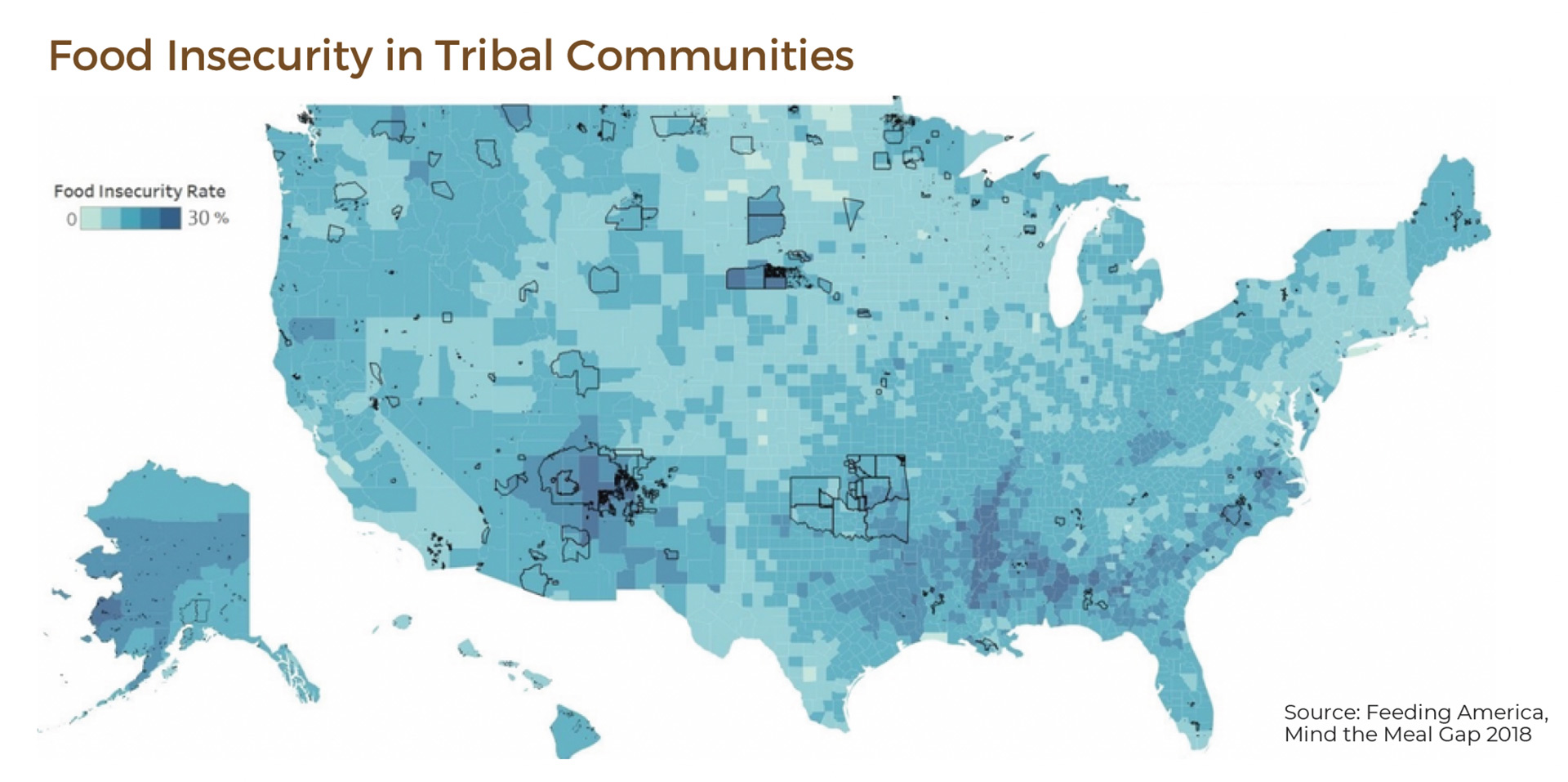
This map shows the food insecurity rate by county with an overlay of Tribal lands for reference. Generally, there are higher rates of food insecurity on Tribal lands.
INDIAN COUNTRY PRIORITIES
- Expand and/or make permanent the 638 program
- Reduce Tribal matching requirement to 0%
- Continue USDA-requested new nutrition education funding in appropriations bills
- Create a direct ITO pilot program of locally produced herbs and spices as part of nutrition education opportunities for FDPIR
- Issue FNS waiver authority to FDPIR sites allowing non-domestically sourced produce in emergencies
- Include more traditional/Tribally produced foods on a regional basis
- Provide Tribal administration authority, funding eligibility, self-determination, and self-governance opportunities for SNAP and all nutrition programs
- Authorize dual use of SNAP and FDPIR
- Support initiatives to approve Tribal administration of TEFAP (Tribal Emergency Food Assistance Program)
- Include more traditional/Tribally purchased foods for the Commodity Supplemental Food Program (CSFP)
- Establish Cooperative Agreement Authority for Tribal Food Procurement in all Farm Bill nutrition programs
People going hungry in Indian Country is too common. At least 25% of all American Indian and Alaska Native people in the United States rely on SNAP to meet their monthly dietary needs, as of 2018.
FARM BILL TITLE V – CREDIT
INDIAN COUNTRY’S HIGHLIGHTS
WHY IT MATTERS TO INDIAN COUNTRY
- There are 80,000+ Native food producers across Indian Country
- Agricultural production requires access to credit borrowed on fair terms — this title supports access to credit for Native producers
A 2014 study showed that while Native CDFIs are providing agricultural loans in Indian Country, agricultural borrowing needs significantly exceed lending capacity. The additional difficulties Native borrowers still experience trying to access private lending systems make FSA programs, authorized through the Farm Bill, a vital source of capital for Native producers.
On average, Native producers carry more debt at higher and sometimes even predatory loan rates than other producers. Continuing to improve programs within the Credit Title so that Native producers can more fully access these programs will improve economic realities for Native farmers and ranchers across Indian Country.
INDIAN COUNTRY PRIORITIES
- Authorize CDFI pilot program
- Establish pilot program authorizing CDFIs to administer Farm Service Agency and Rural
- Development direct funding to illustrate the efficacy of fully exercising the flexibility in existing statutes
- Remove the graduation requirement for FSA programs
- Remove the requirement for private credit denial
Farming and ranching are inherently unpredictable and very capital intensive. Obtaining credit can be difficult for Tribes and Tribal producers, including those engaged in meat, poultry, fish, and seafood processing. Congress should ensure that loan and loan guarantee opportunities are available for the development of meat, poultry, fish, and seafood processing facilities in Indian Country.
Access to credit will assist Tribal communities in developing regional food systems and support tribal member access to traditional, affordable, and nutritional food sources.
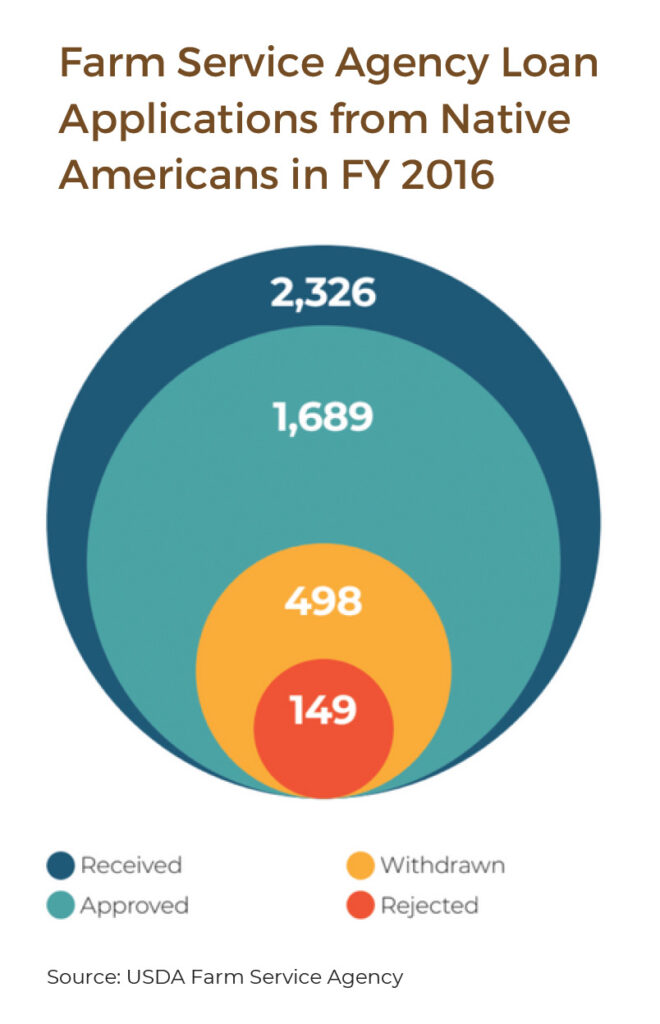
Credit access is so challenging for Native producers that most of Indian Country is referred to as “credit deserts.”
FARM BILL TITLE VI – RURAL DEVELOPMENT
INDIAN COUNTRY’S HIGHLIGHTS
WHY IT MATTERS TO INDIAN COUNTRY
- Rural Development programs can build out much-needed infrastructure in Indian Country in broadband, housing, water, wastewater/sewer, rural business development, and more
USDA programs almost exclusively focus on the needs of rural America, including many who live within Indian Country. Rural Development funds are critical to Indian Country’s agriculture and economic development.
Addressing the infrastructure and investment needs in Indian Country supports rural economies. Tribal agriculture production and food systems are essential economic development drivers in rural America.
INDIAN COUNTRY PRIORITIES
- Implement and expand Substantially
- Underserved Trust Area (SUTA) provisions throughout all rural development programs
- Mandate all programs at RD to support Tribal priority
- Fund Tribal set-asides for all RD programs
- Support Native CDFIs loan authority
Approximately 12% of Tribal homes lack access to safe drinking water and basic sanitation — more than 20 times the national average.
The FCC estimates that 35% of Americans living on Tribal lands lack access to broadband services, compared to 8% of all Americans.

Rural development programs provide essential community infrastructure and assist Tribal Nations in maintaining basic quality of life service.
FARM BILL TITLE VII – RESEARCH
INDIAN COUNTRY’S HIGHLIGHTS
WHY IT MATTERS TO INDIAN COUNTRY
- Covers agricultural research, extension services, economic research, and most grant programs for Tribal Colleges and Universities, as well as other educational and research institutions assisting Indian Country
- Provides programs and funding for agriculture and youth development programs, like the Federally Recognized Tribal Extension Program (FRTEP)
Traditional farming practices and ecological knowledge held by Tribal farmers and other knowledge keepers can improve the diversity, resiliency, and productivity of our food systems while addressing environmental concerns and developing economic sustainability. Research regarding this knowledge should be handled respectfully with consent from the communities and individuals where it originates.
This research requires both full consultation with Tribal governments and compliance with modern cultural practices. It may require data sovereignty and opacity considerations, along with cultural sensitivity training for researchers, in light of the historical exploitation of Indigenous science and the trauma of the colonial education system.
INDIAN COUNTRY PRIORITIES
- Expand Native youth grants in agriculture.
- Implement a Tribal set-aside, preference, and funding at the National Institute of Food and Agriculture (NIFA)
- Tribal Colleges and Universities (TCUs) eligibility for all NIFA funding
- Fully fund FRTEP with mandatory, noncompetitive funds
Regular extension agents serve approximately 200 producers per agent, while Federally Recognized Tribal Extension Program agents serve 10 times that.
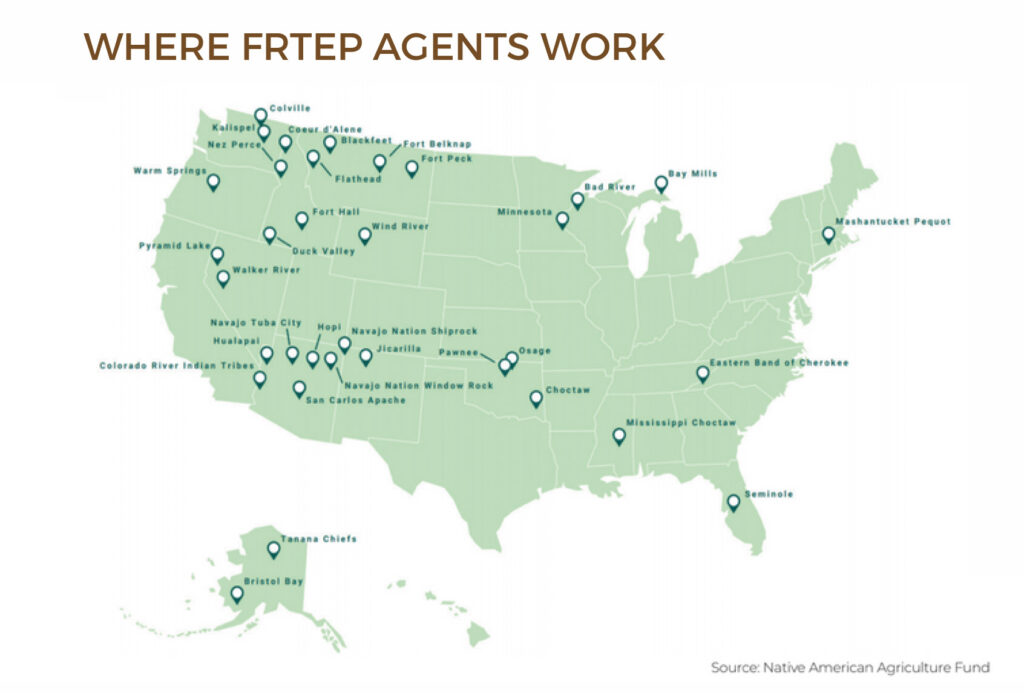
A fully funded FRTEP can support Indian Country food systems and by guiding the next generation of food and agriculture leaders in Indian Country through 4-H programming for Native youth.
Educated Indigenous producers will build more resilient food systems, improve Tribal sovereignty over food and nutrition, and ensure fulfilling and meaningful work in Tribal communities.
FARM BILL TITLE VIII – FORESTRY
INDIAN COUNTRY’S HIGHLIGHTS
WHY IT MATTERS TO INDIAN COUNTRY
- Indian forests and woodlands comprise 18.6 million acres, or one third, of the total 57 million acres of Indian land held and managed in trust by the federal government
- Nearly 55% of Tribes have forests or woodlands.
- Forestry provides more than $40 million in annual Tribal governmental revenues and 19,000 jobs in and around Tribal communities
- This title sets the priorities, planning standards, and cooperative relationships between federal, state, Tribal, and private forest systems
Across Indian Country, forests provide more than $40 million in annual Tribal revenue.
Forests provide 19,000 jobs in and around Tribal communities.
INDIAN COUNTRY PRIORITIES
- Transfer lands back to Tribal Nations
- Give full authority to Tribal Nations and counties to retain and utilize revenue generated from Good Neighbors Agreement projects
- Extend and expand 638 Authority in the Forestry Title and provide additional funding and protection for sacred sites
Tribal Nations have engaged in the management and stewardship of forestlands for thousands of years, but as with most Tribal land management activities, colonization disrupted this practice.
As recently as 2017, 313 federally recognized Tribes have continued to manage forests. Those Tribal forestland holdings ranged in size from one acre to more than 5 million acres; roughly 8 million acres of Tribal forests were timberlands.
Native forests and woodlands comprise 18.6 million acres, or one third, of the total 57 million acres of Native land held and managed in trust by the federal government.
NEARLY 55% of all federally recognized Tribes manage forests
Forests represent one of the principal renewable resources available to Tribes.
FARM BILL TITLE IX – ENERGY
INDIAN COUNTRY’S HIGHLIGHTS
WHY IT MATTERS TO INDIAN COUNTRY
- Energy projects in Indian Country hold immense promise for diversifying Tribal economies while bringing much-needed energy systems to remote and isolated communities
- Indian Country has tremendous wind and solar potential, among other renewable energies
- This title provides funding and research support for alternative energy technology, production of renewable biomass for biofuels, education, research, financial assistance, and the manufacture and production of renewable energy
With 14% of Indian Country’s households lacking access to basic energy needs like electricity, creating more opportunities for Tribes to access Energy Title programs is critical.
Providing renewable energy for Indian Country’s 80,000+ farmers and ranchers will stabilize Tribal agricultural operations and help keep food prices from rising. This is a crucial need for Indian Country, where food prices are already higher than average.
INDIAN COUNTRY PRIORITIES
- Ensure Tribal eligibility in energy authorities
- Create Tribal set-asides in the Rural Energy for America Program (REAP)
- Develop Tribal solar energy grant programs
- Establish Tribal bio-based energy grants
14% of Indian Country’s households lack access to basic energy needs, like electricity
Indian Country has just under 4% of all energy potential in the U.S.
Indian Country holds 5% of the nation’s solar potential

Energy independence for Indian Country, developed through renewable energy projects, would vastly reduce energy costs for Native agricultural producers.
FARM BILL TITLE X – HORTICULTURE
INDIAN COUNTRY’S HIGHLIGHTS
WHY IT MATTERS TO INDIAN COUNTRY
- Increasing fruit and vegetable production is an act of food sovereignty and addresses health issues.
- Surplus horticulture products can be marketed in local and regional food systems, providing more economic opportunities and increasing food access
- This title supports the production, promotion, marketing standards, food safety, and protection of specialty crops like fruits, vegetables, tree nuts, floraculture, and ornamental products. It also provides assistance to certified organic agriculture production
Fruit and tree nut farming increased 2% from 1,853 farms in 2012 to 2,302 farms in 2017.
Greenhouse, nursery, and floriculture farming increased by 20% from 650 in 2012 to 779 in 2017.
Source: USDA National Agricultural Statistics Service
INDIAN COUNTRY PRIORITIES
- Establish protections for Tribal seeds and traditional foods
- Increase food safety compliance support and market access
- Demonstrate support for Tribal organic producers an organic programs
- Include Tribes in the Specialty Crop Block Grant Program (SCBGP)
- Acknowledge Tribal sovereignty in horticulture operations and pesticide regulation
Aside from the economic implications of growing horticulture operations, many of the crops in Indian Country that federal policy today considers to be “produce” and “specialty crops” have been culturally significant foods in Tribal communities for far longer. These are often the traditional or culturally important foods that have nourished Tribal people for thousands of years. With increasing frequency, Tribal actors — either through Tribal governments, Tribally led organizations, or individual Native food producers — cultivate these foods as part of food sovereignty or health equity initiatives.
7% increase in the number of farms with an AI/AN producer from 2012 to 2017
Source: U.S. Census of Agriculture
Stable growth in horticulture operations in Indian Country will improve local food access for everyone in Tribal communities.
FARM BILL TITLE XI – CROP INSURANCE
INDIAN COUNTRY’S HIGHLIGHTS
WHY IT MATTERS TO INDIAN COUNTRY
- Agricultural risk management is critical for producers
- Food production is inherently risky not only from the production standpoint, but also from legal, financial, marketing, labor, and regulatory standpoints
- This title provides insurance programs to producers
Risk management is a critical component of resilient and sustainable American food and agricultural systems. The agriculture industry is considerably volatile due to a variety of factors, well-evidenced by food systems and supply chain disruptions during the coronavirus pandemic, which continue today.
Given the wide variety of climate and geographic regions in the U.S., one central challenge facing producers is the need for stable, reliable agricultural risk management strategies.
INDIAN COUNTRY PRIORITIES
- Mandate additional training on federal food and agriculture programs available to Tribal and individual Native food producers, including training on their application processes
- Empower Indian Country technical service providers to design and conduct federal trainings
- Develop crop insurance for traditional foods and livestock
- Allow Tribal insurance companies to insure Tribal producers
- Appoint Tribal producers to the Federal Crop Insurance Corporation Board
Many insurance products, made available through the Crop Insurance Title, fail to reach Native producers when they are not tailored to respond to the nuances of Indian Country food production systems. Service delivery of subsidized crop insurance is a critical component to the protection of Tribal food and agricultural product production.
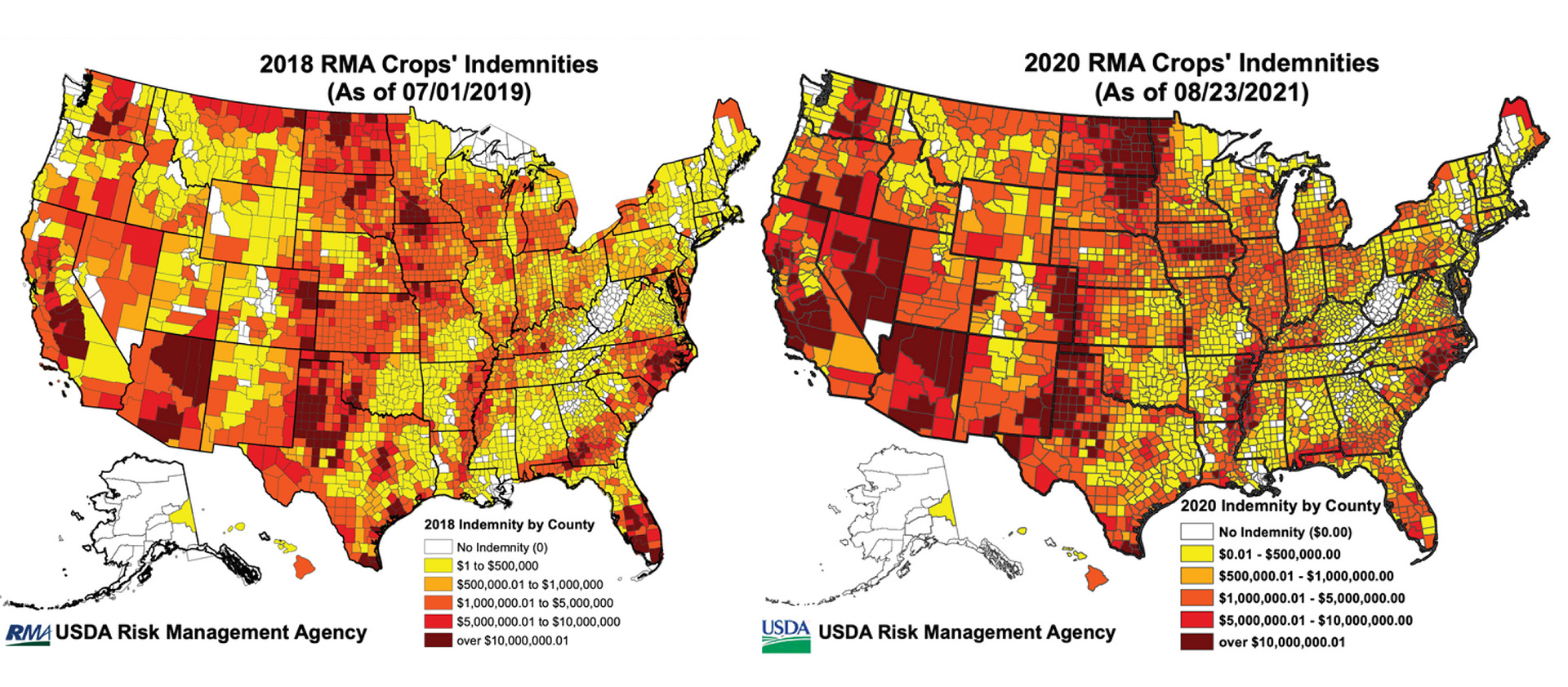
Service delivery of subsidized crop insurance is a critical component to the protection of Tribal food and agriculture.
FARM BILL TITLE XII – MISCELLANEOUS
INDIAN COUNTRY’S HIGHLIGHTS
WHY IT MATTERS TO INDIAN COUNTRY
- While this title operates as a “catch-all” for topics not covered in other titles of the Farm Bill, the Miscellaneous Title has many important programs
- This title has the potential to create broad program authority and policy or management changes with sweeping impacts across all USDA programs and mission areas
The Miscellaneous Title in past Farm Bills has had a positive impact on Indian Country, including the creation of the Office of Tribal Relations and the Tribal Advisory Council.
INDIAN COUNTRY PRIORITIES
- Include competitive enhancement provisions and priority points for Tribal Promise Zones
- Study food fraud and cultural appropriation of Native foods in the marketplace
- Extend the Buy Indian Act and Indian Preference hiring to all USDA programs
- Establish a “First Right of Refusal” for Tribal Nations to purchase available USDA lands in their ancestral territories
- Apply “638” to All USDA programming and 638 office at USDA
- Seat the Tribal Advisory Committee (TAC)
- Include food assistance programs for urban Indian communities
- Recognize Tribal departments of food and agriculture
- Increase cooperative agreements between Animal and Plant Health Inspection Service (APHIS) and Tribes
- Coordinate with BIA on Agricultural Resource Management Plans (ARMP)
The Miscellaneous Title may sound like the kitchen sink of the Farm Bill, but in reality, this final title is often the place to find crosscutting, innovative programs and authorities that reach across all or most of USDA.
Programs across all six subsections of the Miscellaneous Title provide support for producers who are strongly represented in Indian Country.
